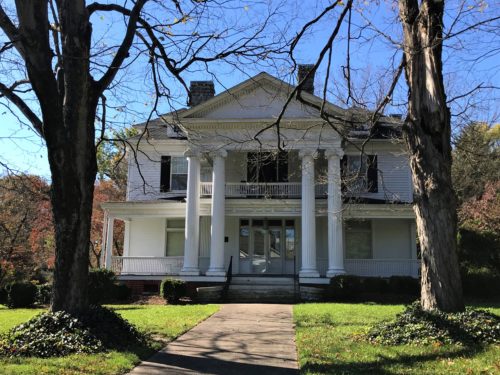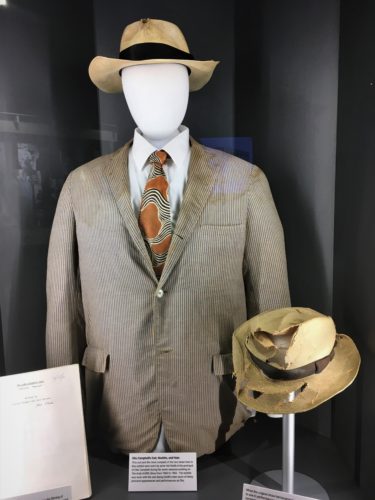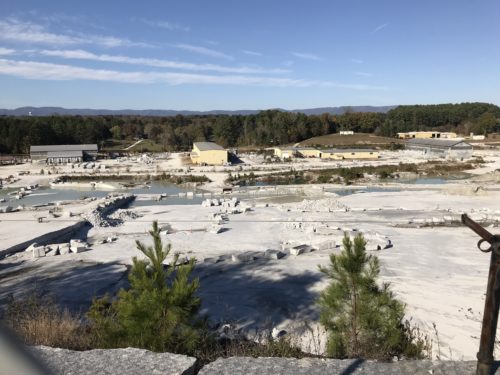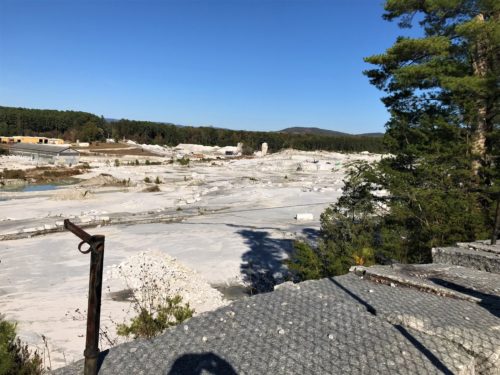Who can whistle the song, “The Fishin’ Hole”? No? OK, how about the theme song for the Andy Griffith Show? I know some of you are doing that right now! 😊 It’ll probably play in your head for awhile . . .
Well, the name of that song is . . . you got it . . .
Today we ventured into Mount Airy, North Carolina (aka Mayberry). Those of you who are old enough (or have an affinity for TVLand) will definitely remember The Andy Griffith Show which aired 259 episodes from 1960-68 and is one of only 3 shows to end on top of the ratings. I Love Lucy (180 episodes) and Seinfeld (also 180) being the other two. I think with those statistics, the designation of “Greatest Show on Earth!” belongs to The Andy Griffith Show. But that’s just my opinion. 😊

Andy Griffith was raised in Mt Airy and used the town as inspiration for his show. To this day, some of the places mentioned on the show are still in business! Floyd’s barbershop and Snappy Lunch, just to name two.
But there are also lots of areas and stores who capitalize on the show’s success – like Barney’s Café and Aunt Bea’s Diner. And you can buy just about anything related to Andy Griffith, et al.
So we dove right into the culture – – eating a pork chop sandwich at Snappy Lunch,

Battered tenderized pork, hot dog chili sauce, cole slaw, tomato It also has onion and yellow mustard, which I opted to omit. And chips were 50 cents extra. The sandwich was $4.20







visiting Andy’s office,

“Now Aunt Bea, just calm down.”
Otis’ jail cell,


Blaine says I look too happy to be locked up
Wally’s Service Center,



Emmett’s Fix It Shop,

the Darling’s truck,

the Morrison sister’s car (I’m sorry, but we just don’t remember this at all!)


You can’t see it in the picture, but Mt Pilot is spelled Mt Polit! : )
and Blaine was supposed to get a haircut at Floyd’s. Unfortunately, the current barber wasn’t there today. Bummer! Instead, we chatted with the son of the inspiration for the show, Russell Hiatt (who died last year at 92). His son, Bill was never a barber. He was a teacher. They have pictures of all the visitors on the walls and in boxes – over 40,000 of them!


We walked up and down Main Street, stopping in Angel’s (NOT part of the show) for pastries and a pie,



I loved this sign in her shop!
and checked out the ‘General Store’,which was actually 13 different shops in one large room. (No picture of this)
And we saw the beautiful Mt Airy Post Office, a couple of old houses and a cool-looking church.

Notice it’s all granite. Check the end of this post to see why! : )

We thought about moving the trash can, but there were a lot of people around. : )

This is an 1860’s bed and breakfast – at least that’s what the sign says out front. There were several houses on this street with the same design. Never would have thought they were old if not for the B&B sign!



Eventually, we left downtown and walked to the Gertrude Smith House, built in 1903.

The front of the house, but you don’t go in here


Instead, you go in the back porch door. It’s less formal – for friends and family.
This is where Billie May met us. : )
Here’s what we learned about Miss Gertrude:
Around the turn of the century, Jefferson Davis Smith built a late Victorian-Colonial Revival house overlooking North Main Street. Smith was a local merchant and landowner who operated a general store, several farms, and numerous rental properties. After his death, his oldest daughter, Gertrude, moved back to the Smith family home and assumed the management of the family businesses. Gertrude, who was an interior decorator, had previously worked with two prestigious decorating firms in New York City and owned her own interior decorating business in Greensboro for many years. She used her decorating talents when she came back to Mount Airy by updating and enlarging her childhood home and filling it with beautiful period antiques. Gertrude was also very involved in historic preservation and was one of the charter members of the Mount Airy Restoration Foundation. It was her passion for preservation that caused her to form the Gilmer-Smith Foundation whose board of directors would oversee the perpetual care of her home. When Gertrude died in 1981 at the age of 90, she willed that the home be left as though it was still occupied and that it be used as a ‘living museum’.
A tour of the Gertrude Smith House gives visitors the feeling that the Smith’s just walked out the back door. Furnishings, accessories and artwork are displayed just as they were when the Smith family lived there. Even the dining room table is set with Miss Gertrude’s china and crystal. Personal items have been carefully placed throughout the home for all who come for a visit to relish, appreciate, and enjoy.
The Gertrude Smith House is open for tours from the beginning of April until the end of December every Tuesday, Wednesday, Friday and Saturday from 11-4. There is no admission charge.
We were met at the back door/porch by friendly and talkative Billie May. I’m guessing she was in her 70’s, and we learned more about her personal life than that of Gertrude – like the kind and dosage of her cholesterol medicine and her recently broken foot. But not once did we hear “Bless your heart!” That’s a really good thing when you’re in the South! It’s a very kind why of telling you you’re an idiot or crazy. Real Southerners are much too polite to actually hurl insults. 😊
Anyway, Miss Billie May kept us going through the house in such a hurry, we didn’t have a chance to take pictures inside. But when we were done, she asked us to sit on the porch with her and talk awhile. We were so surprised, of course we did! But she really didn’t give us a choice. After about 15-20 minutes, another couple came through the door and we were quickly dismissed. 😊
Here’s a picture of the inside from their brochure.

Then we walked back through town

They give tours of the town and share Mt Airy and Mayberry info for a reasonable fee of $35 per carload.
and took in the AG Museum where we learned that early in his life, before he caught the show biz bug, Andy wanted to be a Moravian Priest. How’s that for trivia??
They didn’t have much on display. I think a lot of it wasn’t kept. Who knew how popular it would remain?

Statue donated by TVLand

Otis’ suit. His first had is in the foreground


Goober’s clothes, including a bronzed original cap – but no pictures of Goober (??)

Barney’s suit

Andy’s shirt


Aren’t these incredible!!??!!

They had a section on Betty Lynn aka Thelma Lou.
She’s still living at 90 and does appearances at the museum once a month (I think).
I didn’t include a current picture of her. She hasn’t aged very well. . .
You can google her if you’re interested.

There was also a poster of Andy, but it wasn’t life-size. (??)
When we came out, we discovered Trick-or-Treat was happening on Main Street! The road was closed and that’s where our car was parked, but they let us out, escorted by an officer on a bicycle. Of course, being the friendly little town they are, he talked to us for about 10 minutes before he sent us on our way. Among other things, he’s from Kentucky and his wife’s from Columbus, Ohio. . . 😊

Lastly, to end our day in Mt Airy, we went to visit the North Carolina Granite Corporation. We’d read about an observation area, but when we got there, we were surprised there were no ‘story boards’ giving information on the place. Thank you Google!
Here’s an article I found at www.ourstate.com. You can read as much or as little as you desire. I thought it was interesting, but then I like things like this. : )
Editor’s Note: This story was originally published in September 2012.
The Mount Airy locals call it The Rock.
My father-in-law, the late Jimmy Carpenter, called it that. He worked there for more than 30 years as a journeyman stonecutter. I remember his stories, stories of The Rock’s strength, its size, its beauty. But I couldn’t possibly understand it until I saw it.
The Rock is a mammoth granite quarry east of town. It is a scientific wonder, and its owners have mined it for 120 years, pulling some of the finest white granite in the world — granite they sold to build buildings and war memorials all across the country. The Rock made Mount Airy famous before Mayberry did.
It’s a complex conglomerate of science, history, and geological serendipity that all came together in Surry County eons ago.
It is the world’s largest open-faced granite quarry. On the surface alone, the quarry encompasses about 60 acres, or roughly the equivalent of 66 football fields. Mount Airy lore maintains that astronauts spotted The Rock from space as they orbited the Earth. That’s how large this rock is, and that’s just the part you can see. The mother mass — the block you can’t see — is about 7 miles long and 1 mile wide, north and south. And it’s 8,000 feet deep.
“Geologists tell us we’ve got enough to last for a while,” says Carlos Goad, the vice president of human resources for the North Carolina Granite Corp., which owns the quarry. “In our brochures, we say we have enough to last another 500 years.”
From space, the quarry appears as a white speckle amid a sea of blues and greens. From the rim of the quarry, looking out over the acres of unblemished granite, it’s too big for the eyes. And when you ride across The Rock in a pickup truck, like I did with Goad earlier this year, and you see firsthand the technology, and you feel firsthand the subterranean explosions required to break off large chunks of granite, The Rock becomes a mighty, living fortress. When you tour the company’s fabricating facilities, where the granite saws roar, you see the patience and precision needed to transform raw stone into something else — a beautiful building or a moving memorial. And when you meet the men who make all of this happen, the men who take great pride in harvesting what the rest of the world knows as Mount Airy granite, you begin to understand the importance of this place to the community and to this state.
To the locals, it feels as if The Rock has been here forever. And in reality, that’s not far from the truth.
- • •
The first known story of the land dates back to the 1800s, when a farmer bought the land and considered the large section of rock worthless.
But The Rock’s history goes back much farther than that.
About 336 million years, to be precise. It was then that The Rock formed through a geological process called plate tectonics.
“Our planet is a restless planet,” says Bert Meijboom, a Pilot Mountain geologist who does consulting work for the North Carolina Granite Corp. and is familiar with the granite quarry. “Continental plates are constantly on the move.”
North Carolina sits on the North American plate, Meijboom says. Several times in geological history — remember, we’re talking about millions of years here — that plate has collided with the African Plate. The last time it happened — approximately 360 million years ago — portions of the African plate subsided beneath the North American plate, creating a subduction zone that set the stage for the formation of Mount Airy’s huge granite quarry.
“It was along such a zone, some 12 to 25 miles underneath the American plate, that blobs of molten rock were formed,” Meijboom says. “Due to its relatively lighter weight, the molten rock, also called magma, started to rise toward the surface, intruding the upper portions of the plate.”
The magma slowly solidified over millions of years and formed what’s known as a pluton — basically, a body of igneous rock that develops beneath the earth’s surface. As the plates continued to move and extensive erosion occurred, these plutons — one of which geologists actually refer to as the Mount Airy pluton — appeared at the surface, giving The Rock its designation as an open-faced quarry.
- • •
Harvesting granite from a geological wonder that took millions of years to form is quite a task for humans, especially considering we only began trying about 120 years ago.
Since then, workers have extracted granite down to a depth of only about 60 feet. Granite is a tough, stubborn rock, and extracting the material without damaging it requires a process that’s both rugged and delicate. The beauty of the finished product — smooth and faultless — is a testament to the quarry’s ability to accomplish such a challenging feat.
The extraction process begins with a powerful water jet — yes, water, the same force that cut and shaped so much of the earth — that slices deep grooves in the stone, about 2½ inches wide and up to 21 feet deep. The granite is no match for the forceful water jet, which packs some 40,000 pounds of water pressure per square inch at its nozzle — more than enough to blast through the stone at a rate of about one linear foot per hour. Then comes what Goad refers to as diamond technology to cut the chunk away from the mother mass.
The workers drop a diamond wire into the slots created by the water. The wire saws gently, patiently slicing across the bottom of the loaf of material to free it from the mother mass.
Finally, the fun part: setting off the explosions. Workers drill one-and-a-quarter-inch holes almost through the entire depth of the freed loaf, strategically spaced to yield the size of the granite blocks desired — about 10 feet long, 5 feet wide, and 5 feet deep. Then they drop an explosive called Primacord down into those holes, fill the holes with water — the water magnifies the force of the explosion — and then three, two, one … ka-boom!
Several times a day, such explosions can be heard — but not felt — up to about a mile away from the quarry, always preceded by a warning siren.
“Primacord will generate more of a noise air blast, rather than a ground vibration,” Goad says. “Something like black powder or dynamite would create a ground vibration, but that’s not what we use.”
With the chunks of granite now a more manageable size, workers transport the pieces to the fabricating facilities on sturdy forklifts designed for such a heavy load — 165 pounds per cubic foot, Goad says. The company extracts about 1 million cubic feet of granite per year. That’s more than 82,000 tons of granite annually.
That’s a lot of rock.
To give perspective, consider that a cubic foot is about the size of a basketball. A cubic foot of granite weighs 165 pounds. So imagine a 165-pound basketball. And now imagine 300 of them on a trailer.
The quarry has two fabricating divisions, one for curbing and the other for dimensional stone, which includes the granite used for buildings, memorials, mausoleums, and other products that are as decorative as they are functional. The crushing division reduces granite waste to small pieces sold for landscaping chips and other purposes.
“We’re always going to generate some waste in the quarry through our extraction process, and we generate waste through our production plants as we cut pieces off,” Goad says. “So if we didn’t have this crusher to reduce that material, we’d be under a mountain of waste right now.”
Mount Airy granite is more widely recognized for its dimensional uses — including such high-profile projects as the World War II Memorial in Washington, D.C.; the Arlington Memorial Bridge; and, here in North Carolina, the Wright Brothers Memorial — but it’s also popular for curbing, especially in Northern states.
“They especially like the curbing in states where they get a lot of snow and ice,” Goad says. “A concrete curb will deteriorate in about two or three years due to the salt, but granite is impervious to the salt.”
- • •
That’s granite for you — the rock of ages.
Standing at the public observation area overlooking the vast quarry, Melvin Miles bends over to pick up a small piece of granite, then hands it to a visitor. Miles, who has lived in Mount Airy since 1975, leads tours of the town several days a week, and the quarry is always a part of his tour. He knows most visitors come to see the town that gave us Andy Griffith and influenced fictional Mayberry, but he also enjoys giving them a piece of The Rock.
“Sometimes, you’ll see them kind of roll their eyes, like, ‘Who wants to see a rock?’ ” Miles says. “But then when you get them over there, you can’t get them away from it. They’ve got 10,000 questions, and they don’t want to leave.”
Miles, a retired schoolteacher, can show you everything in town that was built from Mount Airy granite: The post office. The Veterans’ Memorial. The police department. The public library. The municipal building. The many churches, including the Moravian church Andy Griffith attended growing up. The banks and other businesses. The residences. The Visitors Center. The new facade of Mount Airy High School.
He also points out the differences in the granite seen around town — primarily the differences in how the granite was cut. Buildings constructed in the early days have rough pieces of granite cobbled together. As the stonecutting technology improved, the granite became smoother and more uniform.
Miles also likes to remind visitors that the pieces of granite they see in Mount Airy — both at the quarry and in buildings around town — are small pebbles of that huge rock that formed all those millions of years ago.
“Remember, the quarry is seven miles long under the ground,” he says. “It comes all the way under the downtown area. I remember when I first came here and was looking to buy a house. The first thing the realtor told me was, ‘Now we want you to understand there is no more than 24 inches of dirt in your yard anywhere and there’s no basement — it’s solid rock.’ ”
Yes, Mount Airy, known as The Granite City, actually was built on The Rock.
It’s good to remember that from time to time. Mount Airy is one of our most famous little towns, and it has plenty of character throughout it, but if you dig down even just a bit, you can’t forget: The Rock was here long before the city.
And our pictures. No explosions when we were there. Darn!




And a bit off topic, but because it’s Halloween, here’s a couple of pictures of our nephew, Logan in the costume my brother, Lance and wife Kelli came up with – homemade with no directions, no less! Great job as always, guys!

“It”
From Stephen King’s book/movie

Here’s the sunset God blessed us with today!

And now . . . the lyrics you’ve all been waiting for . . .
Well, now, take down your fishin’ pole and meet me at The Fishin’ Hole,
We may not get a bite all day, but don’t you rush away.
What a great place to rest your bones and mighty fine for skippin’ stones,
You’ll feel fresh as a lemonade, a-settin’ in the shade.
Whether it’s hot, whether it’s cool, oh what a spot for whistlin’ like a fool.
What a fine day to take a stroll and wander by The Fishin’ Hole,
I can’t think of a better way to pass the time o’ day.
We’ll have no need to call the roll when we get to The Fishin’ Hole,
There’ll be you, me, and Old Dog Trey, to doodle time away.
If we don’t hook a perch or bass, we’ll cool our toes in dewy grass,
Or else pull up a weed to chaw, and maybe set and jaw.
Hangin’ around, takin’ our ease, watchin’ that hound a-scratchin’ at his fleas.
Come on, take down your fishin’ pole and meet me at The Fishin’ Hole,
I can’t think of a better way to pass the time o’ day.
~Music by Earle Hagen and Herbert Spencer, Lyrics by Everett Sloane (Earle wrote the tune in 15 minutes)
Go ahead. Write ‘em down and sing along next time you watch the show. Or just continue listening to the whistling in your head. 😊
